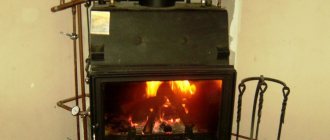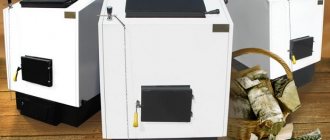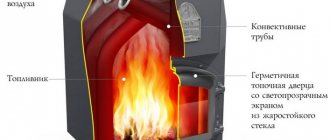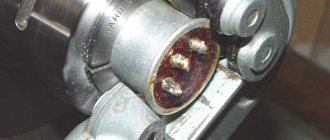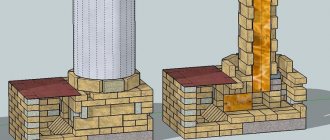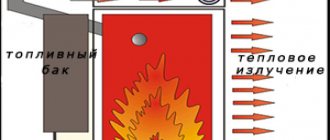Heating fuel
Currently, many scientists from all over the world are engaged in research that will make it possible in some future to obtain a good alternative to flammable materials such as gasoline, kerosene and diesel fuel.
The solution to the problem appeared relatively recently and this is heating oil. Despite this, it has gained great popularity, which is primarily due to its high calorific value and reasonable price.
Once upon a time, various types of fuel were actively used only in industry. Now many consumers are striving to gain independence and complete autonomy. To do this, most people exchange apartments for country houses and cottages, as long as they are as far away from the city limits as possible.
In this regard, the demand for energy resources for domestic needs has increased. Using gas and electricity to obtain the necessary heat in the house is not always rational. What is needed is an energy carrier that is capable of releasing the maximum amount of thermal energy with low consumption. In this regard, heating oil does its job well.
Advantages of furnace energy carrier
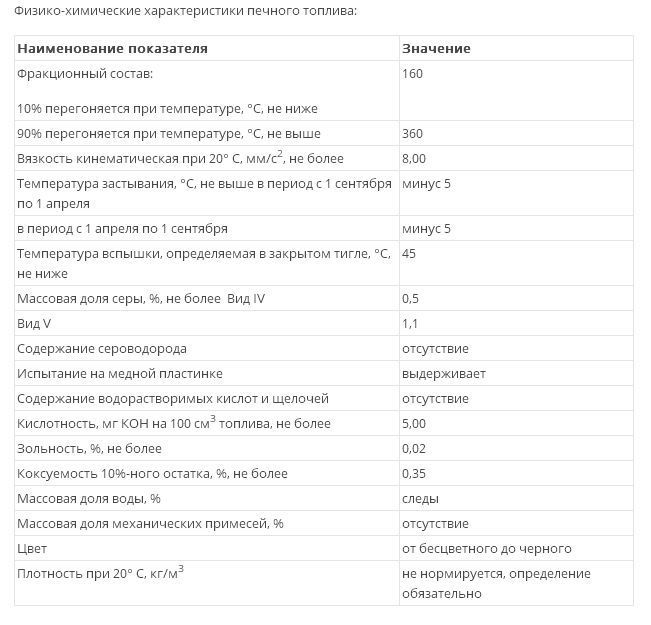
Heating oil characteristics
The wide popularity of heating oil is explained by significant advantages that are difficult to overestimate:
- high efficiency;
- fuel does not have an unpleasant odor;
- long shelf life;
- universal nature of use;
- low freezing point;
- easy transportation;
- simple storage conditions.
In addition, if you use fuel optimally, you can significantly save money on electricity and heating.
Production of alternative fuels
An alternative energy source is produced by secondary distillation of oil. Based on viscosity, fuel can be divided into several types:
- lung;
- average;
- heavy.
In addition to viscosity, other parameters are also important quality factors. Among them, one can highlight the combustion and solidification temperature, how much heat is released during fuel combustion, how much water, sulfur and other impurities it contains. The presence of sulfur divides the fuel into low-sulfur fuel - containing 0.5% of the element, and sulfurous fuel - more than 1% sulfur.

Light and dark heating oil
You can also distinguish between dark and light fuels. It is the light type energy carrier that has a high calorific value. Due to this, the light energy carrier is recognized as the best for generators or heating installations used in domestic conditions.
Dark fuel for stoves is obtained from the processing of diesel fuel material. As a result, it is endowed with special properties. An example is low flash point.
And therefore it is necessary to add additives that were obtained from ethylene and vinyl acetate. Often this type of fuel is used for stationary heating equipment. Otherwise, dark fuel, with the exception of viscosity, is no different from light fuel.
Multi-fuel furnace (working off)
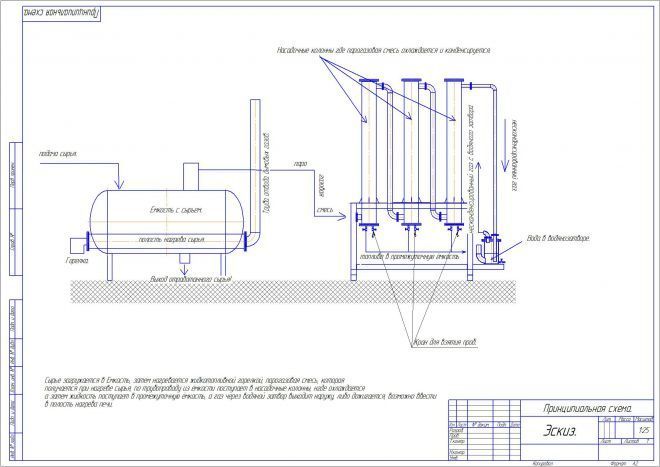
Device for producing dark heating oil
In practice, a method is often used where dark heating oil is clarified. Thanks to special technology, in addition to clarification, the sulfur content can be significantly reduced. But if the dark fuel contains aromatic carbons, the costs of the production process may increase.
Due to the chemical reaction occurring between gas, carbon and biomass, synthetic fuel can be obtained. In most cases, the combustible material is obtained from gas and carbon. But the use of biomass is also gaining popularity.
Only high-tech equipment is used to produce fuel, and the entire process is vigilantly monitored by qualified specialists.
Only thanks to these requirements it is possible to obtain a product of the highest quality.
Fireplace fuel
Wood is the most readily available fuel and is the most popular and renewable resource. Since man learned to use fire, wood has become an important resource for heating homes.
What kind of wood should be used in a fireplace?
Almost any type of wood can be burned in a fireplace or stove, but hardwood is mainly used for heating. The important thing here is the moisture content of the wood. Only dry firewood will provide the highest thermal efficiency and good combustion. Depending on the type of tree and the time of year the tree was cut, the wood contains between 50% and 70% water. Heating a fireplace with wet wood is ineffective and even dangerous. When burned, wet wood has a very low calorific value. When burning such wood, a very large part of the heat is spent on evaporation of water. Water vapor can significantly reduce the draft in the chimney, and often clogs the pipe with a steam plug, which can lead to an inversion of the draft and even an explosion in the fireplace. The main problem with wet wood is the planting of the chimney. Soot in the chimney can ignite, which often causes fires. Therefore, Shidel chimneys have a tee for inspection and cleaning at their base.
Preparation for the heating season.
As they say, prepare your sleigh in the summer. In order to keep the house warm, you need to stock up on firewood in advance. Fresh firewood should be split and stored in a dry, well-ventilated place. A wood shed is most often built to store firewood. Under natural conditions, wood dries to a moisture content of 18-20% within 1.5-2 years. Such wood is considered dry and suitable for use as fuel for a fireplace.
If you use a fireplace for heating, wood or peat briquettes can be an alternative fuel. Briquettes have a humidity of up to 8%, they provide a lot of heat, burn longer and take up less space when stored.
Which type of wood to choose?
Fireplace manufacturers do not recommend using coniferous wood, which contains a lot of resin. During the combustion of coniferous wood, a lot of soot is formed, which is deposited in the chimney, as well as on the walls of the fireplace firebox. A layer of soot of several millimeters reduces the performance and efficiency of the fireplace. A thick layer of soot on the chimney walls can ignite and destroy the chimney. You will get the greatest amount of heat when using solid wood from deciduous trees such as oak, beech, and birch. Such wood will provide more warmth compared to soft varieties of trees such as poplar or linden. In addition, you will need to put wood in the fireplace less often, which will significantly reduce wood consumption in the process of heating your home.
The quality of firewood is an important point, but you need to know how to use the stove or fireplace correctly. You can read about this in the article about operating stoves.
Application area
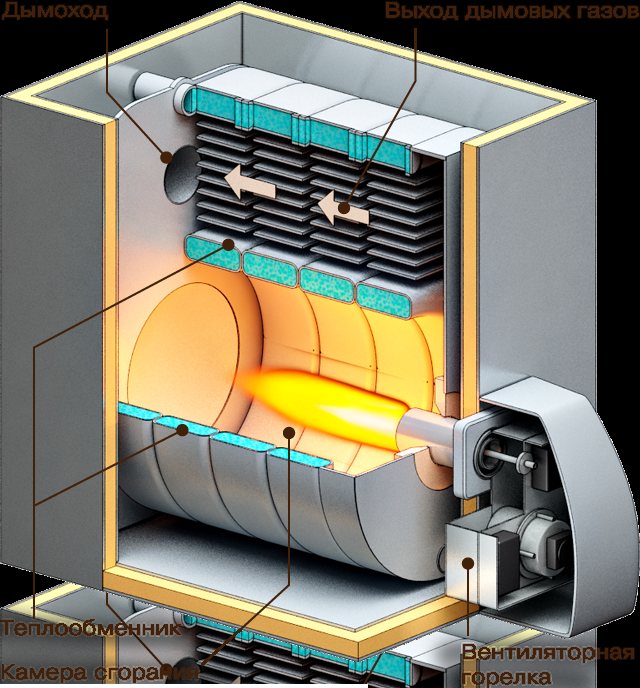
Liquid fuel boiler
As practice shows, household heating fuel has a wide range of applications. Light or dark fuel is actively used among owners of low-power boiler houses, agricultural enterprises, and industrial facilities. But, in addition to industry, the energy carrier is deservedly popular among ordinary consumers.
The fuel is suitable for any heating equipment that runs on liquid energy. In addition to the optimal cost, high demand is due to the inclusion of a large number of various impurities, which cannot be said about purified diesel fuel.
And since stove energy is the best alternative to gas, for most summer residents, in the absence of the possibility of installing a gas pipeline, this is the optimal solution.
Fuel types
When it comes to choosing a suitable design, the first thing to choose is not the fireplace, but the material on which it will work.
- Coal is the traditional and most efficient fuel, as it is characterized by high calorific value. This means that when a certain amount is burned, more heat is released than when burning, for example, brown coal. The latter contains a lot of sawdust and is more humid, which reduces its quality.
- Peat has a lower calorific value, but dries well. In places where peat is abundant, its cost is minimal, and heating with its help is completely justified.

- Pellets are compressed material from wood chips, wood flour, sawdust and even straw and husks. The density of pellets is almost 1.5 times higher than the density of wood, so the calorific value of such fuel is high. Briquettes are made using the same principle. However, the density of the latter is lower, and briquettes, as a rule, need to be dried before use.
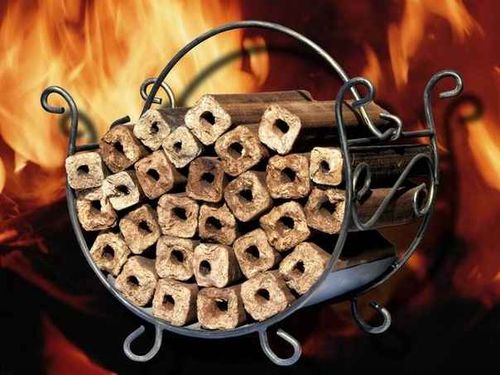
Most models assume the use of only one type of fuel. Coal, firewood and pellets are not interchangeable, since the calorific value and volume of these materials are different, which means the operating conditions are different. If the design provides for such a possibility, then this is indicated in the product passport.
- Gas is also often used in modern versions. Moreover, the chamber with a gas burner can also be equipped with a transparent door, although, of course, burning gas is not at all as attractive as burning coal or wood.
There are combined models that involve several modules for different types of fuel: gas and wood, for example, coal and wood, and so on.
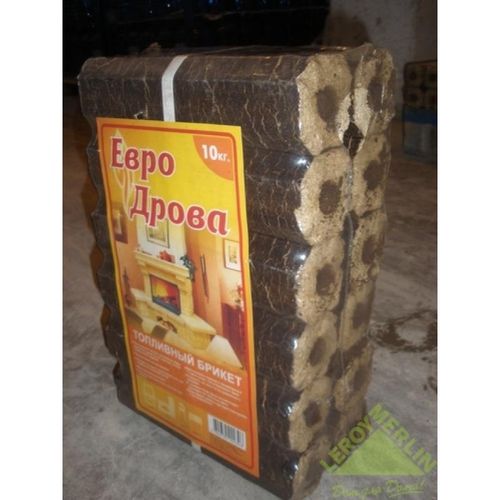
How to store and transport heating oil
There are simply no special requirements that require proper storage of heating oil. The only thing to consider when storing is to use closed containers in which the liquid will circulate. To avoid an increase in viscosity, storing fuel is only permissible in a warm place.
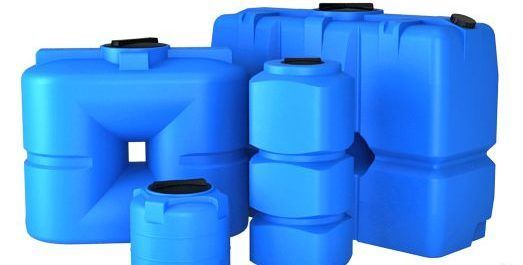
Plastic containers and tanks for fuel
As for transportation, there are no special instructions here either, with the exception of one. For transportation, you need to use a special tank that has a drain hole at the bottom. In addition, the tank must be equipped with a pressure control system and air valves. The container must be filled to 95% of the total volume, no more. Transportation can be carried out both by road and by rail.
If you need to transport a small amount of fuel, you can use smaller containers - cans, polymer barrels.
Heating oil (boiler fuel)
Heating oil used in stationary steam boilers and industrial furnaces. TO boiler fuels include heating oils of grades 40 and 100, produced in accordance with GOST 10585-99.Heating oil is intended for combustion in low-power heating installations located directly in residential premises, as well as in medium-power heat generators used in agriculture for preparing feed, drying grain, fruit, canning and other purposes.
The standard for boiler fuel (GOST 10585-99) or, as it is more often called, heating oil, provides for the production of four grades: naval fuel oil F-5 and F-12, which are classified by viscosity as light fuels, heating oil grade 40 - as medium and grade 100 - heavy fuel.
When producing heating oil, cetane and iodine numbers and cloud point are not standardized. When processing sulfurous oils, the mass fraction of sulfur in the fuel can reach 1.1 percent. Accordingly, heating oil does not meet the environmental requirements for diesel fuel and is much cheaper to produce than fuels of the GOST R 52368-2005 standard.
This is often taken advantage of by unscrupulous resellers who, for the sake of increased profits, sell heating oil under the guise of diesel fuel produced in accordance with GOST R 52368-2005. The price is set 2-3 rubles per liter below the official prices of large diesel fuel producers. Such scammers are periodically caught in the act by law enforcement agencies, but this does not stop those who want to make a quick buck.
It happens that the buyer, for the sake of momentary savings, turns a blind eye to the quality of the fuel. Such a temporary benefit turns into costly repairs of fuel equipment, since low-quality fuel quickly causes high-pressure fuel pumps and injectors to fail.
How can a consumer distinguish high-quality diesel fuel from heating fuel?
- Due to a lower degree of purification, heating oil has a darker color (yellow-brown) compared to diesel fuel.
- If you pour fuel into a transparent container, sediment will appear after a short time.
However, in conditions of fuel acceptance in the dark under artificial lighting, the method of determining quality “by eye” may not work.
How to avoid buying low-quality goods? There is a solution: purchase fuel from a reliable, time-tested supplier, which is MOSDIESEL.RF.
MOSDIESEL.RF – Your equipment will last longer!


